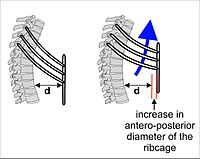Introduction
The provision of oxygen and removal of carbon dioxide is vital to human beings and is carried out by inspiration and expiration processes. Inspiration happens during the contraction of muscles such as the diaphragm and ribcage while exhalation (expiration) occurs more passively at rest. These processes change slightly when breathing is forced.
The Lungs and Breathing
Lungs are covered in visceral and parietal pleura whereby space in between the lungs and thoracic wall is known as pleural space. This space usually fills with pleural fluid forming a pleural seal used to hold the lungs’ outer surface against the inner surface of the thoracic wall. This is of importance in ensuring that during the expansion/contraction of the thoracic wall, the lungs move along due to the tension at the surface of the pleural fluid that creates the pleural seal.
Boyle’s Law
The law states that when the temperature is constant, the volume of gas is inversely proportional to pressure. Inferring this law, the lungs expand, increasing the air volume within them; thus,the pressure reduces. The point whereby air pressure outside the lungs is greater than that inside, the air is forced into the lungs and vice versa.
Inspiration
With the contraction of various muscles, inspiration allows air to move into the lungs.
- The diaphragm and the external intercostal muscles undergo contraction.
- During the contraction of the diaphragm, it’s flattening presses down on abdominal contents, thus lifting the thoracic cavity. This leads to a volume increase in the cavity.
60 to 80% of ventilation is done by the diaphragm; therefore, it is of great importance.
- An elevation of the ribcage and sternum is caused by the contraction of the external intercostal muscles.
- These actions lead to an increase in lung volume.
- The pressure outside the lungs is greater in comparison to the inside lung pressure, which causes a rush of air into the lungs due to the pressure difference.

Passive Expiration.
This is the removal of air from the lungs at rest. It relies on elastic recoil as:
- Relaxation of the diaphragm and external intercostal muscles.
- The stretched lungs recoil back to their original volume, an action caused by elastic recoil.
A reduced volume of gas causes a pressure increase of the air within the lungs as per Boyle’s Law.
- Rushing of air out of the lungs as gas molecules travel from a high-pressure area to low pressure area since the pressure in the lungs is greater than the pressure outside.

Forced Breathing.
With the assistance of accessory muscles, the active inspiratory and expiratory effort is required during forced breathing.
Forced inhalation.
This process follows the steps of normal inhalation but additionally requires effort from inspiratory accessory muscles, including pectoralis major and minor, scalenes, sternocleidomastoid, serratus anterior and latissimus dorsi.
Forced exhalation.
This is an active process that involves the contraction of abdominal muscles forcing the diaphragm upwards to reduce the thoracic cavity volume. Furthermore, there is a contraction of both the internal intercostal muscles and innermost intercostal muscles to pull the ribs downwards. These actions lead to a decreased volume of the thoracic cavity, thereby increasing the pressure in the lungs. This forces air out quicker compared to normal exhalation.
